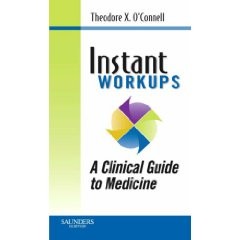Learners, particularly medical students and junior residents, sometimes have difficulty translating disease-based knowledge of pathology, pathophysiology and laboratory medicine to complaint-based real world medicine. They might know, for example, what “classic” acute heart failure is supposed to look like, but they might have some trouble wrapping their minds around the question of how to approach a patient who comes with a complaint that might point to heart failure, for example, shortness of breath or peripheral edema. In addition, some learners have a hard time making the transition from the comprehensive history and physical examination taught in medical school to the more focused H&P that is done in clinical practice.
These are the voids that Instant Workups: A Clinical Guide to Medicine by Theodore X. O’Connell (2008) aim to fill. Each complaint listed–and there are seventy-three of them–has a general discussion that helps the reader figure out how to approach the problem, a list of potential contributing medications or toxins, specific causative diseases, key features to look for on a focused history and physical examination, as well as a suggested laboratory and imaging workup. This is exactly the type of information that new learners need to have at their disposal as they complete their transition from the classroom to the clinic or hospital.

The approach to peripheral edema, for example, is excellent. The common causative agents such as NSAIDs and calcium channel blockers are mentioned. The suggested workup is very well done as well. It includes, serum electrolytes, urinalysis, liver function tests, TSH, chest radiography and electrocardiography.
The index is excellent too. I would, however, consider adding a few internal cross references as well. For example, the author notes (p. 221) that “the three main causes of hypervolemic hyponatremia are congestive heart failure, liver cirrhosis, and renal impairment.” The workups for heart failure and liver disease are not subsumed within the workup of hyponatremia. Rather, they are found elsewhere in the book in the paragraph for peripheral edema (p. 278) and transaminase elevation (p. 361). It would therefore be helpful to cross reference these item internally so that the learner can be pointed in the right direction without having to go back to the index.
I highly recommend this book to medical students and junior residents, and to anyone who wants to have a better understanding of how internal medicine specialists think.
Sample of book available here.


Leave a Reply